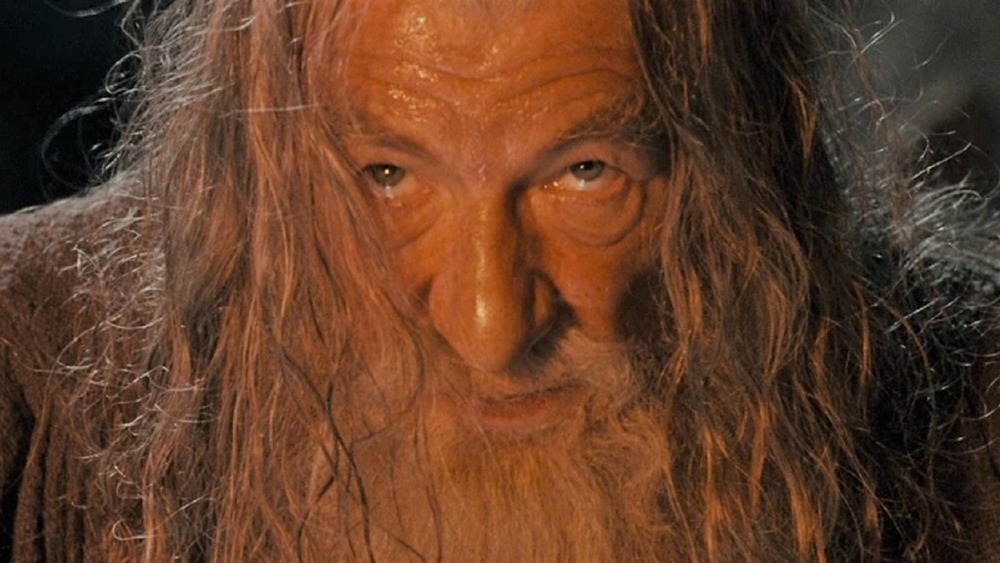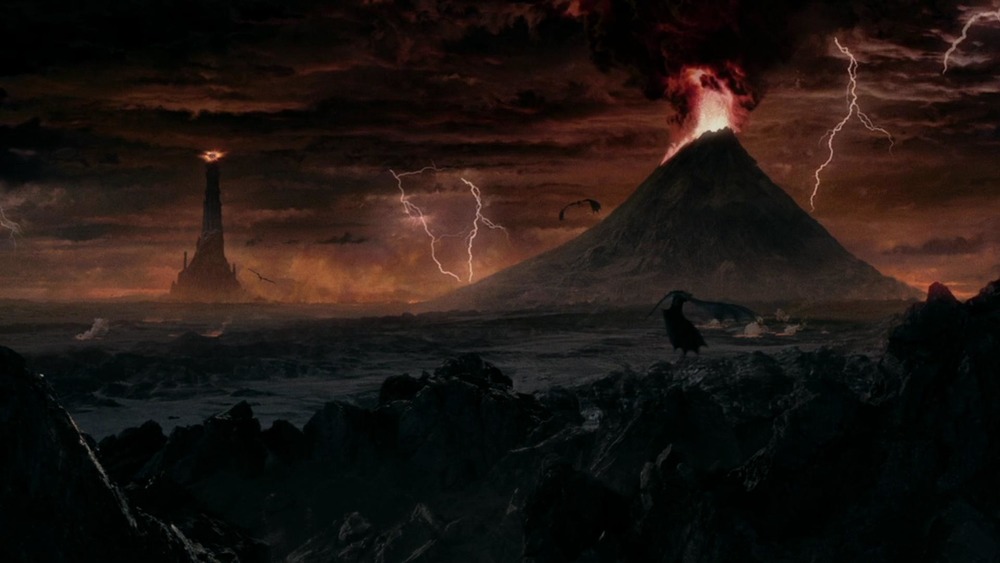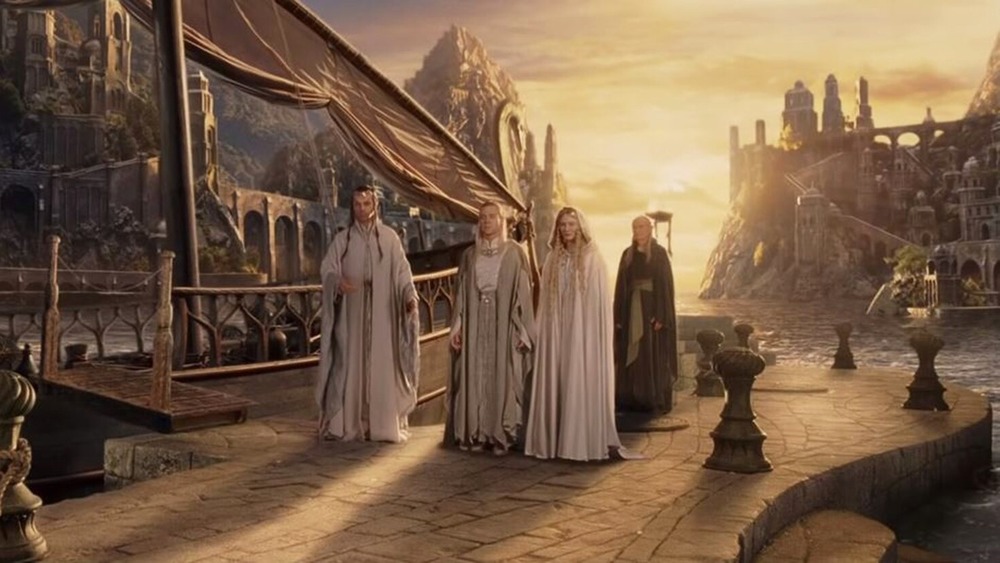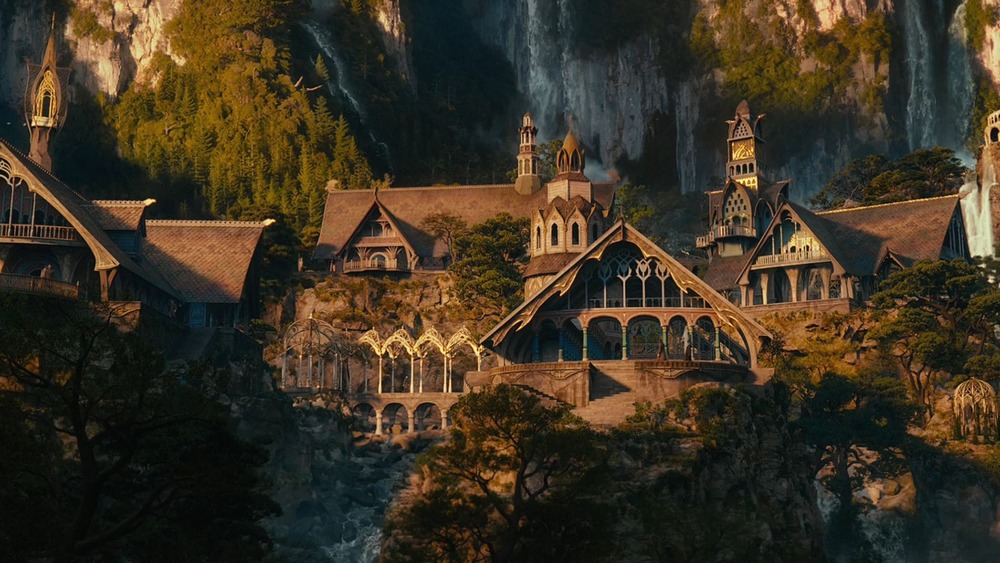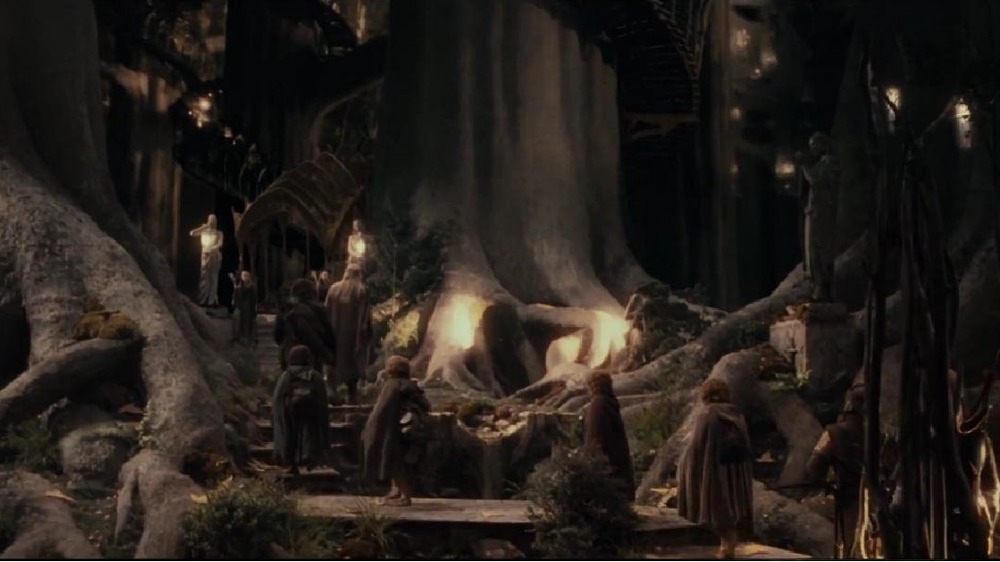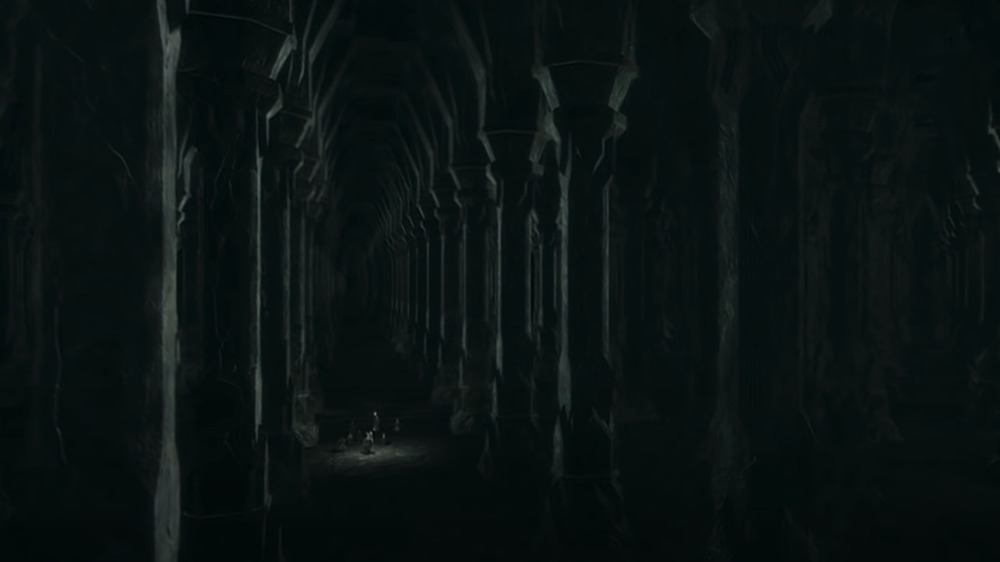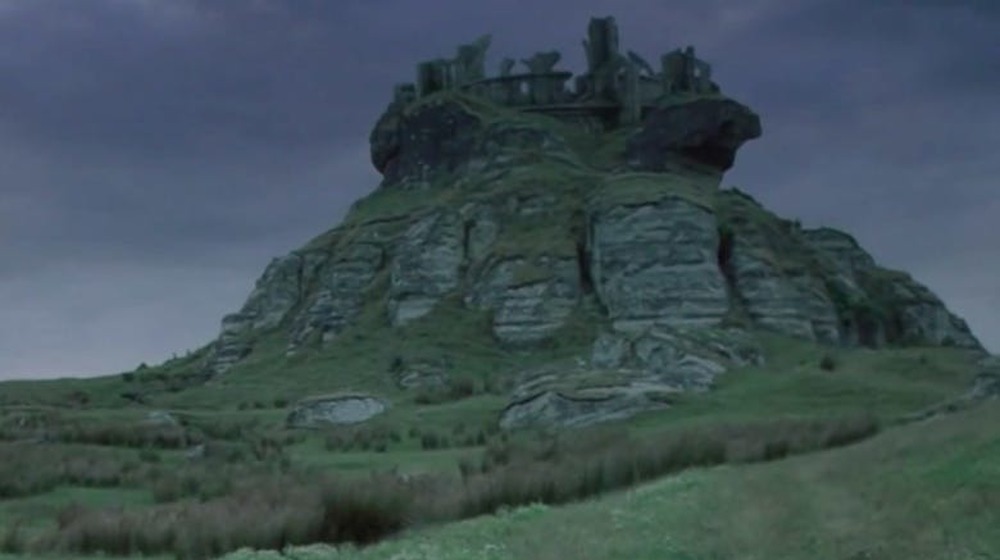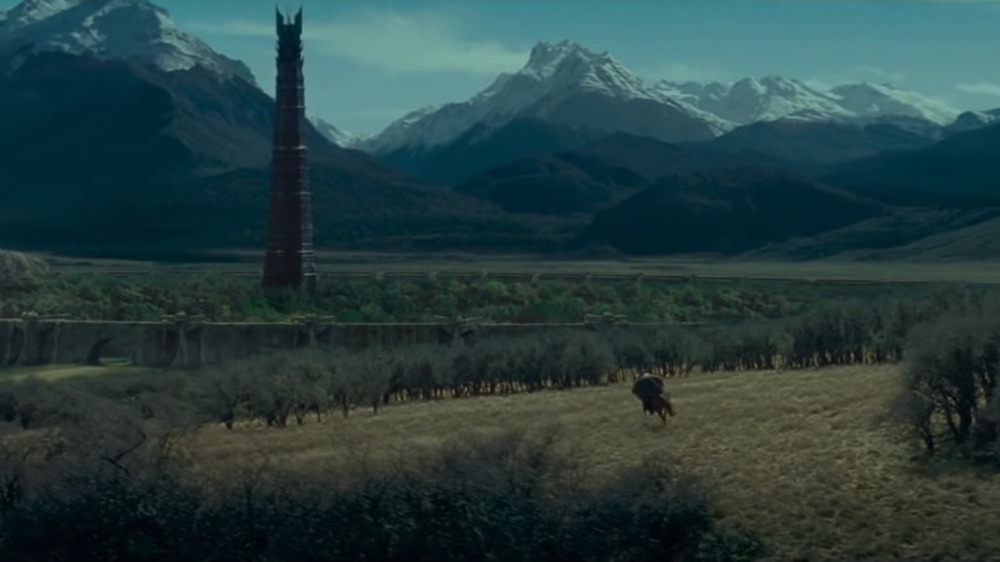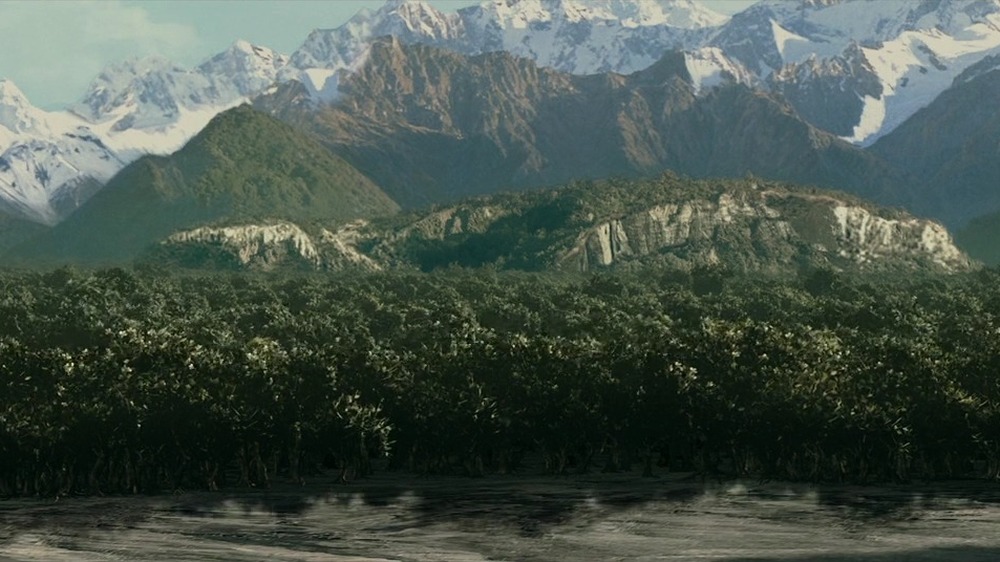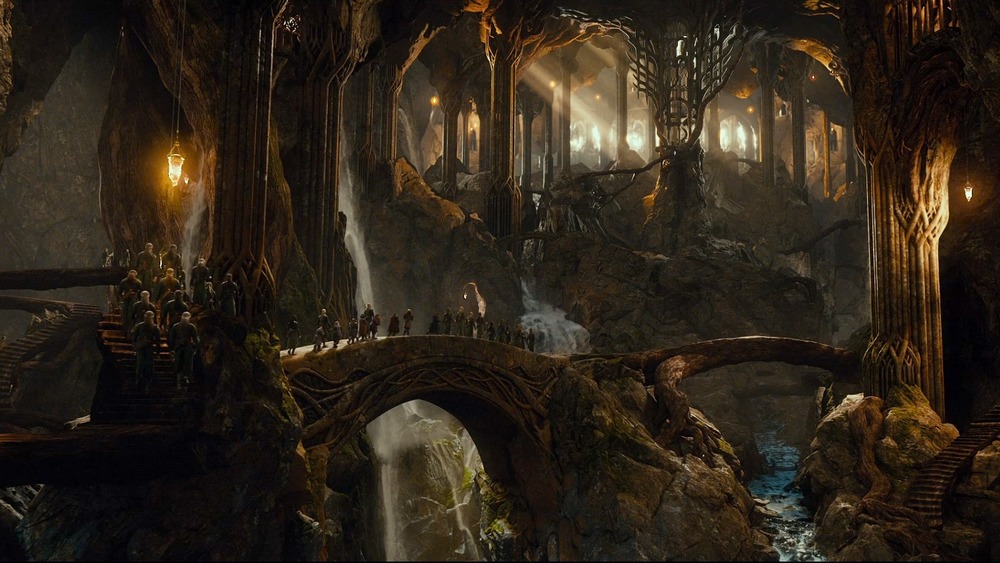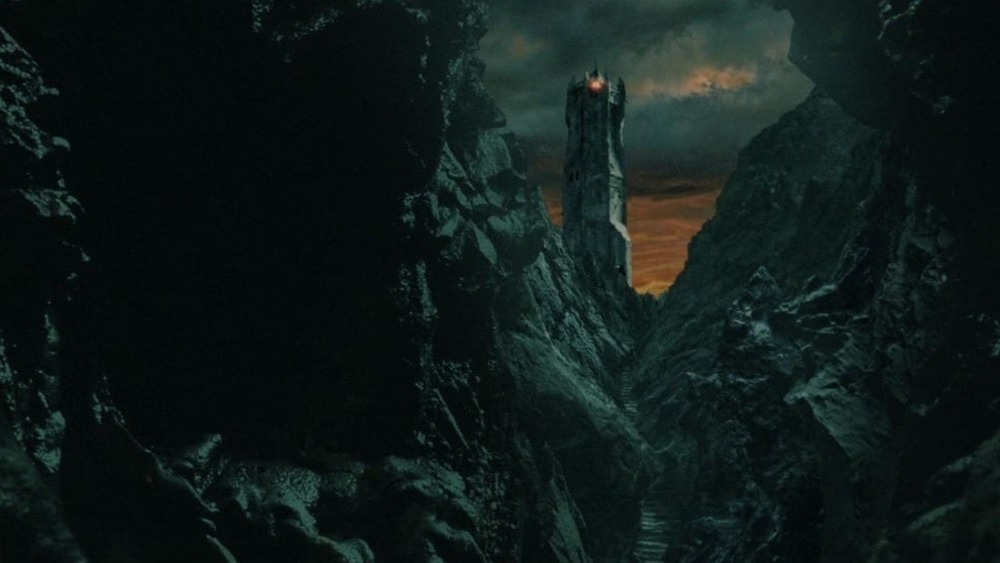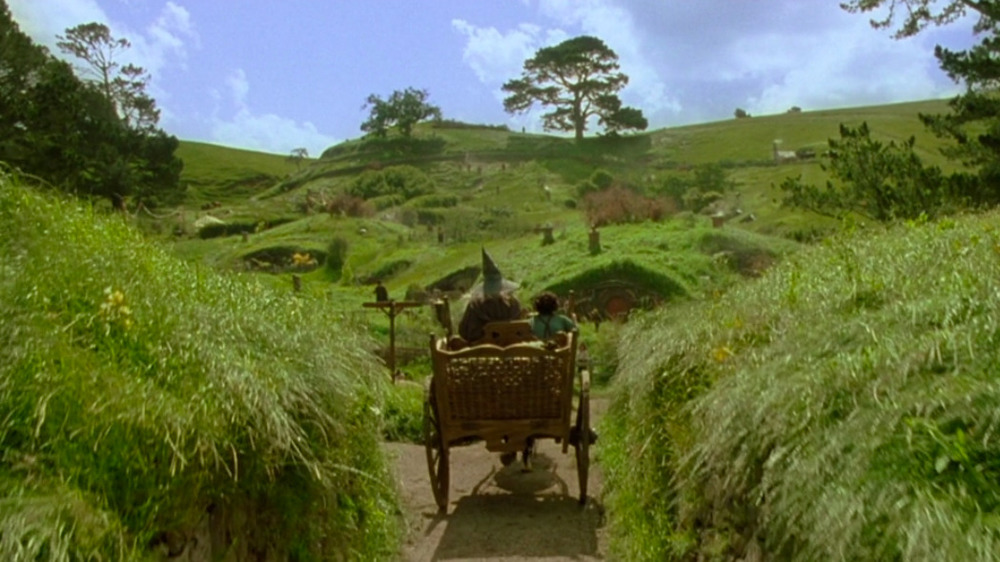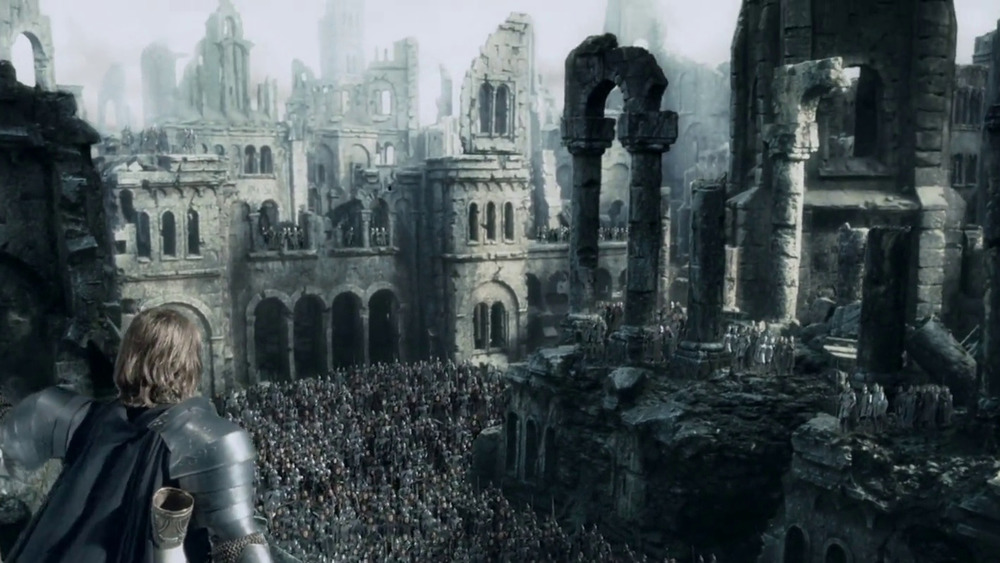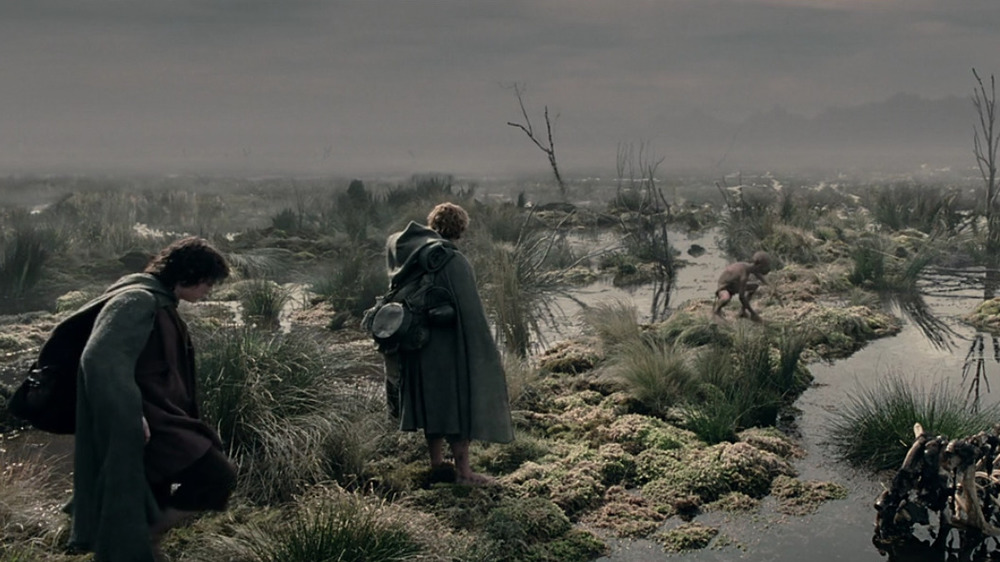Iconic Middle-Earth Locations You Can Expect To See In Amazon's LOTR Prequel
Amazon Studio's ginormous Middle-earth streaming project will be going back thousands of years before the events of The Lord of the Rings (LOTR). The show will be set firmly in the Second Age of J.R.R. Tolkien's mythos. This means some characters — like Elrond, Galadriel, and even the Dark Lord Sauron — are likely to show up early and often. However, thousands of years is a really long time from a mortal perspective. Beloved characters like Frodo and Aragorn certainly won't be making an appearance, even if Elijah Wood is up for the opportunity. Heck, this far back in history, there may not even be a hobbit in sight, as their vague prehistory doesn't start until well into the Third Age.
The point is, we're talking about a very different era in Middle-earth history. And yet, even with the huge time gap, there are still going to be ways that the new show can connect to the existing cinematic world, particularly when it comes to locations. There are a ton of venerable landmarks in Peter Jackson's flicks that could easily make a youthful appearance in a Second Age show. With that in mind, we've gathered up some of the most iconic places you can expect to see during Amazon's new foray into the endlessly entertaining realm of Middle-earth.
Amazon's LOTR prequel might simply walk into Mordor
If there's one location that serves as a focal point of the entire LOTR trilogy, it has to be Mordor. Sauron lives there, Gollum is captured and tortured there, and Frodo is tasked with the very unenviable job of finding a way to break into the Dark Land in order to destroy the One Ring. From beginning to end, Mordor — and particularly Mount Doom and Sauron's tower of Barad-dûr — are central to the plot.
The good news for Tolkien fans is that these are also very important locations in the Second Age. However, while Mordor is already well-established by the time Frodo sets out from Bag End, it will just be getting started during Amazon's show.
In the appendix for The Return of the King, it explains that roughly 1,000 years into the Second Age, Sauron "chooses Mordor as a land to make into a stronghold." It also adds that, "He begins the building of Barad-dûr." This isn't an overnight project, either. It takes Dark Lord a whopping six centuries to finish his intimidating capital. Around the same time that he's purchasing a welcome mat for his fancy new tower, he also uses his mountainous forge of Orodruin (Mount Doom) to create the One Ring. So, chances are we'll get to see both the forges of Mount Doom in action and the construction of the tower that ultimately goes down in calamitous ruin at the end of The Return of the King.
We'd love to witness the Grey Havens during the Second Age
During the Second Age, the elves are more involved in geopolitical events than they are by the end of the Third Age. And at this time, one of their most powerful kingdoms is Lindon, located just to the west of what will later be known as the Shire. Lindon is a very powerful kingdom that's ruled by the elven high king, Gil-galad. This influential monarch also gets some administrative help from a younger elvish noble named Elrond — ever heard of him?
What does all of this have to do with familiar locations? Well, it turns out that by the time of LOTR, a small remnant of Gil-galad's people has continued to maintain a dwelling at the elvish haven of Mithlond. Also known as the Grey Havens, this is the very place where Frodo and Bilbo meet Elrond, Galadriel, and Gandalf to set sail into the West at the end of The Return of the King.
As will be the case often throughout the series, we're talking about seeing the genesis of something that's already fallen from glory by the time of The Lord of the Rings. That means if Amazon decides to visit the Grey Havens, rather than being an off-the-beaten-path elvish stronghold that's quietly ferrying immortal people into the West, it would be a newly built area acting as a central point for the powers of good.
Amazon's prequel series could show a war-torn Rivendell
Elrond spends a good portion of his early career with King Gil-galad in Lindon. At a certain point, he leads an army sent from the elvish kingdom to fight with Sauron. When his host is defeated, Elrond retreats northward to the edge of the Misty Mountains where he establishes a new stronghold called Imladris. Also known as Rivendell, this fortress attracts many survivors from the ongoing struggle with Sauron and eventually becomes a critical resistance point against the Dark Lord.
Rivendell is one of the most iconic places in all of Middle-earth. Both The Hobbit and The Lord of the Rings make multiple stops at the elvish refuge, including the famous Council of Elrond. In all of these cases, Elrond's domain is seen as a quiet, peaceful, even homely residence.
Of course, things were way different during the initial founding of Rivendell. In fact, the fortress remained under siege for years after it was established. This is quite a different picture from the peaceful, elvish oasis that fans of LOTR cinema have gotten used to. No doubt Amazon will have fun dramatizing the events and setting the stage for one of the greatest geographic landmarks in all of Middle-earth history.
Lothlorien would have a very different feel
Lothlorien is an ancient elvish dwelling, with various woodland folk having lived there since the earliest days of their history. However, in the Second Age, the land looks very different from the thriving kingdom that the Fellowship of the Ring finds hidden deep in the heart of an enchanted forest.
For one thing, Galadriel and her husband, Celeborn, aren't even be there yet. At least, not initially. Partway into the Second Age, Galadriel does visit Lothlorien, but even then, she doesn't do so as a ruler. The humongous, silver-barked and golden-leafed Mallorn trees that define the look of the Third Age's Lothlorien aren't there, either, as Galadriel is the one who initially brings the seeds for the mighty arboreal wonders.
While Lothlorien could certainly be in the show, it's going to have a very different vibe. Even so, it could still be heavily involved in the action. The area will likely be ruled by an elvish leader named Amdír, and his people will do their part in the first round of fighting with Sauron.
There won't be a demon in Khazad-dûm
In The Lord of the Rings, the Fellowship of the Ring travels through the Mines of Moria. At that time, they expect to see Gimli's cousin, Balin, a hope that's dashed when they discover the dwarven kingdom in ruins. The area is also referred to "the Black Pit," a moniker created thanks to the evil Balrog that lives there.
However, in the Second Age, there's no fiery demon on the premises yet. Instead of Moria, the area is known as the already-ancient dwarven kingdom of Khazad-dûm, which is still in its heyday. In fact, when the kingdom likely shows up in Amazon's production, all those empty hallways and subterranean auditoriums will be well-lit and filled with busy dwarven folk, which is going to be sweet to see in action.
Additionally, the gates at the entrance — you know where they "speak, friend, and enter" — will likely be made during the show. Not only that, but they're created by one of the coolest artistic team-ups in all of Tolkien's writings. Khazad-dûm is located next to the elven kingdom of Eregion, which happens to be the home of a famous elvish craftsman named Celebrimbor. This is the same guy who helps create the Rings of Power. At one point, he joins forces with the dwarven craftsman Narvi, and the unlikely pair create the magical moonlit doors.
Weathertop is a special place in LOTR lore
Early in The Fellowship of the Ring, Frodo and his hobbit companions are attacked by the Nazgûl on the hill of Weathertop. They're saved by Aragorn, who simultaneously duels five of the Black Riders in the midst of a pile of rubble. The story moves on from Weathertop fairly quickly, but it turns out that the hill — and more specifically, the pile of rubble — may actually end up making an appearance in Amazon's Second Age show ... and not as a wrecked heap of stones, either.
Toward the end of the Second Age, settlers from the island nation of Númenor arrive on the mainland of Middle-earth and set up two kingdoms. One is in the south and goes by the familiar name of Gondor. A second kingdom — one that's long gone by the time of The Lord of the Rings — is created in the north. This kingdom is called Arnor, and for centuries, it's a powerhouse. In The Fellowship of the Ring book, Aragorn explains to the hobbits that "long before, in the first days of the North Kingdom, they built a great watch-tower on Weathertop, Amon Sûl they called it." He adds that "it was tall and fair." The tower is so important that they actually keep one of the seven palantíri (a collection of magical seeing stones) housed there for safekeeping.
Amazon's prequel could provide answers about Orthanc
Saruman's capital of Isengard is defined by the tower of Orthanc, which rises steeply up from the center of the otherwise low-to-the-ground cityscape. But the tower isn't just majestic as it rises above the surrounding lowland. It's also magical. When the Ents try to destroy the tower (after having just destroyed the surrounding walls bit by bit without breaking a sweat), they're barely able to leave a mark on its solid surface.
How did such a strangely unique structure come to exist in the middle of nowhere? It's a topic that Amazon's show could help to answer. While Tolkien doesn't give too many specifics about the origin of Orthanc, it is most likely built in the last years of — you guessed it — the Second Age. Established by the expertly skilled men of Númenor, the edifice is one of the seven towers across the continent chosen to hold each of the seven seeing stones called the palantíri. While the tower is eventually handed over to Saruman for safekeeping — which, yeah, nice move — it starts as an important bastion for a powerful upstart kingdom looking to guard itself against the wiles of the nearby Sauron.
We'd love to get lost in Fangorn and the Old Forest
Fangorn Forest is a unique place in Middle-earth. Not only is it a dense, ancient wood, it's also the only known place where Ents still reside during The Lord of the Rings, and you can bet your bottom dollar that the forest will be there during the Second Age. In fact, at this point in Tolkien's history, the sprawling wood is much larger and may even connect with the Old Forest directly adjacent to the Shire, which is hundreds of miles away.
The presence of previously large and extensive woods across Middle-earth is hinted at multiple times in Tolkien's writings. In The Two Towers, Treebeard tells Merry and Pippin that, in the past, "I could walk and sing all day and hear no more than the echo of my own voice in the hollow hills." In addition, at the Council of Elrond, the learned elf points out, "Time was when a squirrel could go from tree to tree from what is now the Shire to Dunland west of Isengard." In other words, Frodo's entire journey from the moment he leaves the Shire until he reaches Moria used to be a densely wooded region.
Tolkien was a huge lover of nature, especially of trees. It would be exciting to see some of his larger woodland concepts — of which we catch small glimpses in LOTR — able to find a visual representation in the upcoming show.
The Woodland Realm is a fascinating place in elvish history
The Woodland Realm, which lies nestled in the northern end of Mirkwood, plays a central role in The Hobbit story. King Thranduil, Legolas' dad, captures Bilbo and his dwarvish compatriots during their quest to the Lonely Mountain. From beginning to end, the presence of the elves makes for some splashy dramatics in Mr. Baggins' adventure.
However, it turns out that this isn't the first time that the arboreal elves have gotten entangled in the larger affairs of Middle-earth. In fact, by the time of The Hobbit, their woodland kingdom has already existed in Mirkwood for thousands of years, ever since the first half of the Second Age. At that point, Legolas' grandfather, Oropher, sets up shop in the giant wooded region where he rules over a thriving kingdom.
Oropher's people ultimately get mixed up in the events of the Last Alliance (the giant war depicted in the opening of The Fellowship of the Ring), and the elvish king dies in battle there. The melodramatic early history of the elves of Mirkwood makes it an exciting prospect for the show to revisit as Legolas' ancestors get elvish kingdom up and running.
How did Minas Ithil and the Tower of Cirith Ungol fall into darkness?
When Frodo, Sam, and Gollum attempt to enter Mordor, they go through a pass that's home to a ghastly city inhabited by the Nazgûl and their armies. They dodge this by heading up a steep mountain pass where they encounter Shelob ... and then another fortress, this time built right into the mountainside.
Both of these insidious strongholds are filled with all sorts of evils. However, they didn't start that way. These are works of the men of Númenor, this time via their colonized nation of Gondor. Here, on the edge of Mordor, the Second Age heroes built a sister city to Minas Tirith, which they called Minas Ithil, aka the Tower of the Moon. Additionally, they built the tower of Cirith Ungol high up in the pass above.
As Sam realizes in shocking fashion in The Return of the King, both of these structures "had been built not to keep enemies out of Mordor, but to keep them in." In other words, both Cirith Ungol and Minas Ithil were initially built by men of Gondor at the end of the Second Age and early in the Third Age after they defeated Sauron for the first time.
Will Amazon's LOTR prequel visit the Shire and Bree?
Let's rip this band-aid off quickly. The truth is, there's little to no chance that we're actually going to see the Shire that we all know and love in the Amazon show. The actual hobbit-filled Shire doesn't appear on the map until well into the Third Age. However, that doesn't mean we won't see the area again.
For one thing, the Shire is right near Gil-galad's kingdom of Lindon, which figures to feature prominently in the show. Additionally, Galadriel and Celeborn also temporarily rule over a colony of elves in the region. One way or another, there's a good chance we'll see those rolling green hills, even if they don't have any halflings living in them yet.
The nearby community of the Bree-land is more likely to show up in the new show. The half-hobbit, half-man collection of trading towns are established in the Second Age, and they're initially in the area of Gondor's sister kingdom of Arnor. While it probably won't look quite the same, Bree and its fellow townships could definitely play a role in the story. Who knows, maybe we'll even be able to see Barliman Butterbur's ancient ancestors building the Prancing Pony.
We want to see Osgiliath and Minas Tirith before the orcs ruined everything
In The Return of the King, the invasion of Gondor begins with hordes of orcs invading a ruined city called Osgiliath. From there, they attack what's the capital city of Gondor at the time — Minas Tirith. Except that, well, if you go back far enough — say to the Second Age — it's actually the ruined city that's the capital of the nation. And the mighty stronghold of Minas Tirith? Oh, yeah, that's just a tower built to help protect the massive and thriving nearby metropolis.
If Amazon's show takes us through the fall of Númenor and the establishment of Gondor — which it probably will at some point — it will be difficult not to include a version of Osgiliath that's not such a fixer-upper. The chance to see Osgiliath in a state so epic that it makes Minas Tirith feel like no more than a guard tower is likely an opportunity that Amazon Studios won't pass up.
The LOTR prequel might wade back into the Dead Marshes
When Frodo, Sam, and Gollum head through the Dead Marshes, they encounter some creepy aquatic ghouls that haunt the mucky quagmire. These paranormal apparitions take on the appearance of good and bad creatures alike. It begs the questions, what are they, and how did they get into that forsaken area of the world?
The answers can be found in the Second Age, after the War of the Last Alliance. This epic confederation of elves, men, and dwarves attacks Sauron in Mordor itself. However, before they enter the evil kingdom and defeat the villain, they fight a huge battle in front of the gates of the Dark Land. This is where Legolas' grandfather dies, as well as the then-king of Lothlorien, Amdír.
In The Two Towers, Gollum explains "there was a great battle long ago," and the armies "fought on the plain for days and months at the Black Gates. But the Marshes have grown since then, swallowed up the graves; always creeping, creeping." Amazon's prequel could provide the perfect platform to show in painful detail how the Dead Marshes earned their macabre name.
